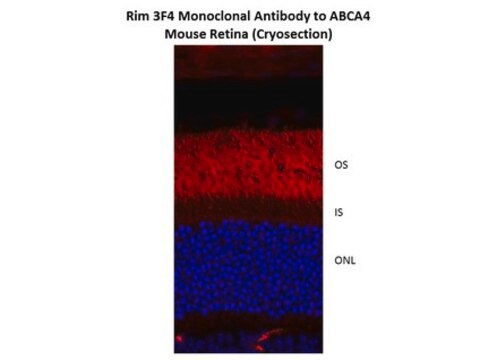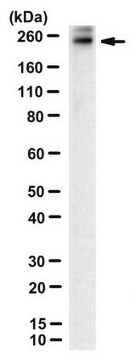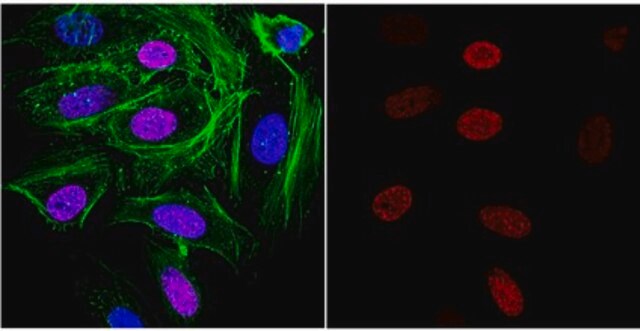MABN1775
Anti-ABCA4 Antibody, clone TMR1
clone TMR1, from mouse
Sinonimo/i:
Retinal-specific ATP-binding cassette transporter, ATP-binding cassette sub-family A member 4, RIM ABC transporter, RIM protein, RmP, Stargardt disease protein
About This Item
Prodotti consigliati
Origine biologica
mouse
Livello qualitativo
Forma dell’anticorpo
purified antibody
Tipo di anticorpo
primary antibodies
Clone
TMR1, monoclonal
Reattività contro le specie
human, mouse
Reattività contro le specie (prevista in base all’omologia)
bovine (based on 100% sequence homology)
tecniche
immunocytochemistry: suitable
immunofluorescence: suitable
western blot: suitable
Isotipo
IgG1κ
N° accesso NCBI
N° accesso UniProt
Condizioni di spedizione
wet ice
modifica post-traduzionali bersaglio
unmodified
Informazioni sul gene
human ... ABCA4(24)
Descrizione generale
Ref.: Tsybovsky, Y et al. (2010). Adv. Exp. Med. Biol. 703, 105-125.
Specificità
Immunogeno
Applicazioni
Immunocytochemistry Analysis: A representative lot detected similar cellular localization of wild-type and ABCA4 missense constructs with either or both L541P and A1038V mutation by fluorescent immunocytochemistry staining of 4% paraformaldehyde-fixed, 0.1% Triton X-100-permeabilized HEK293 transfectants (Zhang, N., et al. (2015). Hum. Mol. Genet. 24(11):3220-3237).
Immunofluorescence Analysis: A representative lot detected ABCA4 immunoreactivity in retina cryosections from wild-type mice and mice with heterozygous L541P;A1038V (PV) missense mutaion, but not mice with homozygous PV mutation (Zhang, N., et al. (2015). Hum. Mol. Genet. 24(11):3220-3237).
Neuroscience
Qualità
Western Blotting Analysis: A 1:125 dilution of this antibody detected ABCA4 in 10 µg of human retina tissue lysate.
Descrizione del bersaglio
Stato fisico
Stoccaggio e stabilità
Altre note
Esclusione di responsabilità
Non trovi il prodotto giusto?
Prova il nostro Motore di ricerca dei prodotti.
Codice della classe di stoccaggio
12 - Non Combustible Liquids
Classe di pericolosità dell'acqua (WGK)
WGK 1
Punto d’infiammabilità (°F)
Not applicable
Punto d’infiammabilità (°C)
Not applicable
Certificati d'analisi (COA)
Cerca il Certificati d'analisi (COA) digitando il numero di lotto/batch corrispondente. I numeri di lotto o di batch sono stampati sull'etichetta dei prodotti dopo la parola ‘Lotto’ o ‘Batch’.
Possiedi già questo prodotto?
I documenti relativi ai prodotti acquistati recentemente sono disponibili nell’Archivio dei documenti.
Il team dei nostri ricercatori vanta grande esperienza in tutte le aree della ricerca quali Life Science, scienza dei materiali, sintesi chimica, cromatografia, discipline analitiche, ecc..
Contatta l'Assistenza Tecnica.







